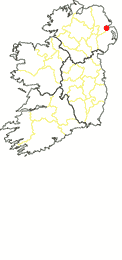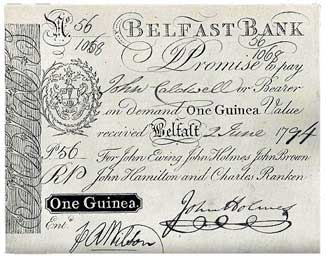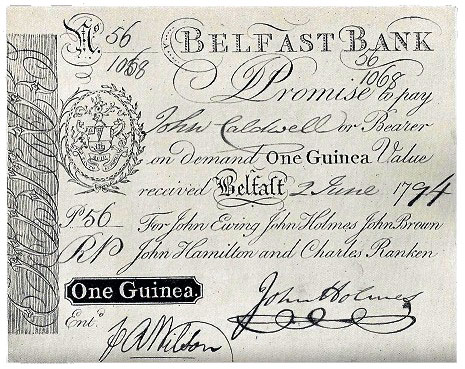

The Belfast Bank of Ewing and Company had origins in a solid financial background. In 1785 a discounting house, the Belfast Discounting Company, started operating in the city, and quickly developed into a lucrative business. The twelve partners in the Belfast Discounting Company included the 'four Johns', John Ewing, John Holmes, John Brown (1752–1801)[2], and John Hamilton, who left to form their own banking partnership in 1787 [1. Young 1973, p. 240].
The bank founded issued notes under the title of the Belfast Bank, and became known as the ‘Bank of the Four Johns’. The Belfast Bank opened on 1 June 1787 [Belfast Newsletter No.5203, as cited by Young, 1973]. By all accounts, it was a well run and trusted bank which operated widely across Ulster.
Ewing's bank is not to be confused with Gordon's Belfast Bank which was founded in 1808, around a decade after the closure of Ewing's. There appears to be no connection whatsoever between the two banks.
The 'four Johns' initially located their bank in The Parade (now Castle Place), but then moved to a purpose-built building in Ann Street on 4 November 1788, and moved again in December 1793 to Bank Buildings [Young 1973].
Charles Ranken (d. 1802) [3] joined the Belfast Bank partnership in 1794. Ranken had been in a banking partnership (Cunningham's Bank, ca1787-1793) with Waddell Cunningham which closed on 31 December 1793, and had been operating out of Bank Buildings which had been constructed by Cunningham, one of the wealthiest businessmen in Belfast [3].
In keeping with other later Belfast-based banks such as the Belfast Commercial Bank, Gordon and Co., and Montgomery's Northern Bank, Ewing's Belfast Bank had likely been a well-run business and ceased to operate in an orderly manner, with all of its notes and other debts being fully honoured.
In November 1796 Ewing, Holmes and Brown all resigned leaving the bank with just two partners, Hamilton and Ranken. It is unknown why the three partners all resigned together.
John Brown had been involved in politics as well as banking, and was one of the wealthiest men in Belfast. He went on to be elected sovereign (mayor) of Belfast in 1797 after leaving the bank [2]. He was a freemason, and had been a major in the Belfast battalion of Volunteers in the 1780s and a captain in the yeomanry during the 1790s. He was captured by United Irishmen in June 1798, but escaped and resumed his office of sovereign of Belfast until his death in November 1801.
Young (1973) cites an advertisement in The Dublin Gazette, no.6465, by Hamilton and Ranken and dated 24th March 1797 in which the two partners announce the dissolution of their partnership, and presumably the closure of their bank.
Hamilton and Ranken continued to be mentioned in the almanacs until 1800, and may have remained in business as a discounting house [Young 1973].
Very little is known about Ewing's note issues. Known examples are similar to notes issued by the Scottish banks of the time, being square rather than rectangular.
Examples of notes of Ewing's Bank are very rare. The only surviving denomination known is for 1 Guinea although it is likely that notes of higher denomination were issued.
One Series of notes known
There is one Series for Ewing's Belfast Bank banknotes by design, and three Types by partnership.
Series 1. 1794. Denominations recorded: 1 Guinea. The design format of the banknote is similar to that of Scottish notes of the time. The 1 Guinea denomination is unusual for Irish banks of this era and suggests alignment with practices in Scotland where notes for sums of less than £5 were permitted rather than in England where notes below £5 were prohibited by an act introduced in 1777.
Three Types by partnership.
Type A: 1787-1794. John Ewing, John Holmes, John Brown, John Hamilton.
Type B: 1794-1796. John Ewing, John Holmes, John Brown, John Hamilton, Charles Ranken.
Type C: 1796-1797. John Hamilton, Charles Ranken. (Nov. 1796 - March 1797).
Denominations recorded: 1 Guinea.
Series 1, Type B

Belfast Bank, John Ewing and Co. One Guinea 2 June 1794
References
1. Young, D. (Nov-Dec 1973). The Private Banks and Their Notes, Belfast Bank (Ewing & Co.) 1787-1797, Irish Numismatics Magazine, No. 36, pp. 239-240.
2. Dictionary of Irish Biography, John Brown, banker and Mayor of Belfast. https://www.dib.ie/biography/brown-john-a1011
3. Dictionary of Irish Biography, Waddell Cunningham. https://www.dib.ie/biography/cunningham-waddell-a2312